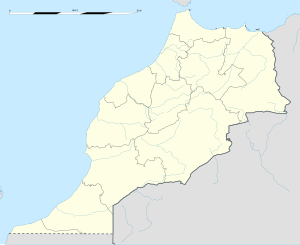Salee
|
Salé سلا |
||
|---|---|---|
 |
||
|
||
| Location in Morocco | ||
| Coordinates: 34°02′N 6°48′W / 34.033°N 6.800°W | ||
| Country |
|
|
| Region | Rabat-Salé-Kénitra | |
| Government | ||
| • Mayor | Noureddine Lazrek | |
| Elevation | 11 m (36 ft) | |
| Population (2014) | ||
| • Total | 982,163 | |
| Time zone | WET (UTC+0) | |
| • Summer (DST) | WEST (UTC+1) | |
Salé (Arabic: سلا Sala, Berber ⵙⵍⴰ Sla) is a city in north-western Morocco, on the right bank of the Bou Regreg river, opposite the national capital Rabat, for which it serves as a commuter town. Founded in about 1030 by Arabic-speaking Berbers, the Banu Ifran, it later became a haven for pirates as an independent republic before being incorporated into Alaouite Morocco.
The city's name is sometimes transliterated as Salli or Sallee. The National Route 6 connects it to Fez and Meknes in the east and the N1 to Kénitra in the north-east. Its population is approximately 900,000.
The Phoenicians established a settlement called Sala, later the site of a Roman colony, Sala Colonia, on the south side of the Bou Regreg estuary. It is sometimes confused with Salé, on the opposite north bank. Salé was founded in about 1030 by Arabic-speaking Berbers who apparently cultivated the legend that the name was derived from that of Salah, son of Ham, son of Noah.
The Banu Ifran Berber dynasty began construction of a mosque about the time the city was founded. The present-day Great Mosque of Salé was built during the 12th-century reign of the Almohad sultan Abu Yaqub Yusuf, although not completed until 1196. During the 17th century, Rabat was known as New Salé, or Salé la neuve (in French), as it expanded beyond the ancient city walls to include the Chellah, which had become a fortified royal necropolis under the rule of Abu Yaqub Yusuf's son, Abu Yusuf Yaqub al-Mansur.
...
Wikipedia


